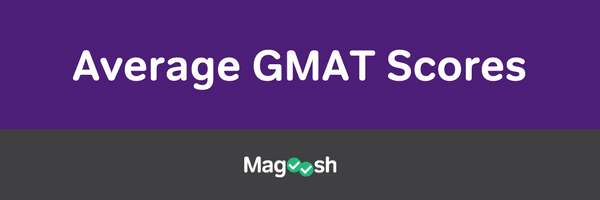
Wondering what the relationships between GMAT scores and the top MBA programs in America are? We’re here to show you what the average GMAT scores are for the entire test taking pool, along with scores for the top 50 U.S. based programs. Also included are the GMAT score ranges (either full or middle 80%) to better assess where your own score lands. Use this blog to help set your score goals and smartly jumpstart your GMAT prep.
Table of Contents
- Average GMAT Scores, New Edition
- Average GMAT Scores for the Top 50 MBA Programs
- GMAT Score Ranges for the Top 50 MBA Programs
- Percentile Rankings
- Takeaway
Average GMAT Scores, New Edition
The current average total GMAT score in 2025 is 553.35. Note that this is for the present-day GMAT (also called the GMAT Focus Edition) that uses the 205 to 805 total score scale.
We can also break the mean scores down by section:
| Section | Mean Score |
| Verbal | 79.28 |
| Quantitative | 78.05 |
| Data Insights | 74.89 |
| Total Score | 553.35 |
Sample Size: 596,155
Data Period: 2019-2024
Average GMAT Scores for the Top 50 MBA Programs
You need a top score to stand out at a top business school. At the top 20 business schools in America, you generally need a score of at least 665 to be competitive. Still, even in these top programs, some applicants are accepted with scores lower than 645. And a school’s own stated GMAT score preferences can change from year to year. At schools ranked from 30-50, scores tend to range from the high 500s to the low 600s, albeit with outliers on both sides.
In 2025, most full-time MBA programs are still reporting Classic GMAT score information. Only a select few—Yale SOM, Berkeley Haas, and Boston University (Questrom)—officially report GMAT Focus numbers.
We’ve translated those Classic GMAT score data points into rough GMAT Focus equivalents based on the GMAT Score Concordance Table that GMAC (the makers of the GMAT) publishes.
Additionally, though most business schools publish an average GMAT score, some instead report a median score. These are denoted in the table above with an asterisk at the end of their name.
GMAT Score Ranges for the Top 50 MBA Programs
Many business schools also share the GMAT score ranges for the students they’ve accepted into their current classes. Sometimes this is the full range of scores, and other times this is the Middle 80% of the range.
Applicants often worry too much about whether their score is above or below the average. What these ranges show is that students with a wide variety of scores get accepted. Having a high score does make you stand out, but having a below-average score doesn’t end your chances of admission. Your test score is ultimately one piece of your application, and business schools take a holistic approach to how they evaluate you as a candidate.
| USNWR Ranking | School and Source Link | GMAT Focus Accepted Score Range | Classic GMAT Accepted Score Range |
|---|---|---|---|
| Northwestern University (Kellogg) | Full: 585-785 | Full: 640-780 | |
| Stanford University | Full: 525-795 | Full: 560-790 | |
| University of Chicago (Booth) | Full: 555-785 | Full: 590-780 | |
| Massachusetts Institute of Technology (Sloan) | Middle 80%: 635-715 | Middle 80%: 690-760 | |
| Dartmouth College (Tuck) | Full: 595-785 | Full: 650-780 | |
| Harvard University | Full: 515-795 | Full: 540-790 | |
| New York University (Stern) | Full: 635-735 | Full: 690-760 | |
| Columbia University | Full: 555-785 | Full: 600-780 | |
| Yale University | Middle 80%: 645-715 | Middle 80%: 700-760 | |
| University of California, Berkeley (Haas) | Middle 80%: 635-695 | Middle 80%: 690-750 | |
| University of Virginia (Darden) | Middle 80%: 615-715 | Middle 80%: 680-760 | |
| Duke University (Fuqua) | Middle 80%: 615-715 | Middle 80%: 660-760 | |
| University of Michigan–Ann Arbor (Ross) | Middle 80%: 635-715 | Middle 80%: 690-760 | |
| Cornell University (Johnson) | Middle 80%: 615-685 | Middle 80%: 660-740 | |
| University of Texas–Austin (McCombs) | Middle 80%: 595-685 | Middle 80%: 650-740 | |
| Carnegie Mellon University (Tepper) | Middle 80%: 585-685 | Middle 80%: 640-740 | |
| University of California–Los Angeles (Anderson) | Middle 80%: 615-695 | Middle 80%: 670-750 | |
| Vanderbilt University (Owen) | Middle 80%: 615-675 | Middle 80%: 680-730 | |
| University of Washington (Foster) | Middle 80%: 615-675 | Middle 80%: 665-730 | |
| Georgetown University (McDonough) | Middle 80%: 585-675 | Middle 80%: 640-730 | |
| Ohio State University (Fisher) | Middle 80%: 615-655 | Middle 80%: 659-710 | |
| Washington University in St. Louis (Olin) | Full: 515-785 | Full: 550-780 | |
| University of North Carolina–Chapel Hill (Kenan-Flagler) | Middle 80%: 615-675 | Middle 80%: 680-730 | |
| Rice University (Jones) | Middle 50%: 615-675 | Middle 50%: 680-728 | |
| University of Georgia (Terry) | Middle 80%: 595-685 | Middle 80%: 650-740 | |
| The University of Texas at Dallas (Jindal) | Middle 80%: 595-645 | Middle 80%: 650-700 | |
| University of Rochester (Simon) | Middle 80%: 575-675 | Middle 80%: 620-730 | |
| Michigan State University (Broad) | Middle 80%: 555-665 | Middle 80%: 600-720 | |
| University of Wisconsin–Madison | Middle 80%: 585-615 | Middle 80%: 640-680 | |
| Boston College (Carroll) | Middle 80%: 515-615 | Middle 80%: 549-684 | |
| Boston University (Questrom) | Middle 80%: 615-675 | Middle 80%: 669-732 |
As stated earlier, most business schools still list only Classic GMAT score information on their websites. We’ve translated those values into rough numbers for GMAT Focus scores using GMAC’s GMAT Score Concordance Table.
Percentile Rankings
According to GMAC, the GMAT score percentiles reveal the link between the GMAT scores and percentile ranks of everyone who takes the GMAT. Percentile rankings help you see how your test performance fares against all other test takers in a certain window. Schools will sometimes publish percentiles, rather than scores, as their benchmarks for acceptance. Looking at percentiles as well as section and overall scores can help you set smarter goals.
| Score | Average Score | Percentile Ranking |
|---|---|---|
| 805 | 100% | |
| 755 | 100% | |
| 705 | 98% | |
| 655 | 91% | |
| 605 | 72% | |
| 555 | 553.35 | 49% |
| 505 | 28% | |
| 455 | 15% | |
| 405 | 7% | |
| 355 | 3% | |
| 305 | 1% | |
| 255 | 0% | |
| 205 | 0% |
Takeaway
What does this mean for you and your scores? Check out how GMAT percentiles work. If you’re not sure about your score, check out Magoosh’s GMAT score calculator first, then check out what this means for percentiles! Consider a Magoosh Premium GMAT Plan to help you meet your score goals to get into a top MBA program.




